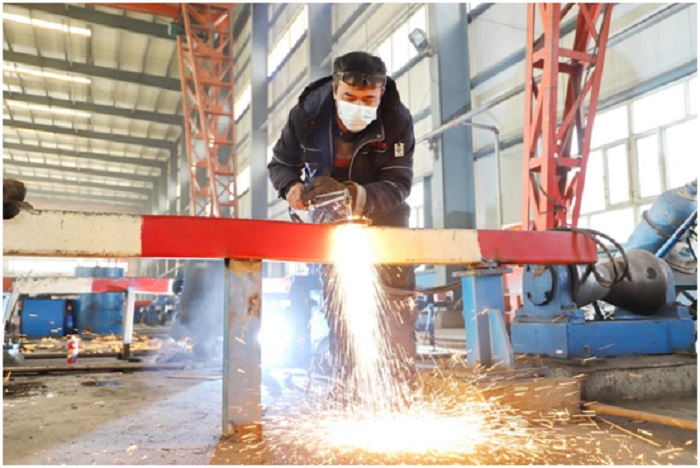



In an effort to meet the rapidly rising market demand for skilled workers, China, which already has more than 200 million skilled workers, is trying harder to increase supplies by strengthening government-subsidized vocational skills training and accelerating the implementation of various plans for improving workers’ vocational skills across the country.
Data from the country’s Ministry of Human Resources and Social Security (MOHRSS) showed that the proportion of skilled workers in China’s total work force stood at 26 percent, and more than 50 million, or about 28 percent, of them are highly skilled.
However, considering the country’s overall employment situation and economic development needs, the current amount and structure of skilled workers in China are still insufficient.
According to the MOHRSS, China has trained more than 40 million people in government-subsidized vocational skills training sessions during the past two years, and is pushing forward with the implementation of relevant plans in various cities.
North China’s Shanxi province plans to spend two billion yuan ($308.2 million) on vocational skills training for two million people, and help one million technical professionals obtain certificates this year; southwest China’s Yunnan province decides to use a special fund of 1.4 billion yuan to improve people’s vocational skills and hold vocational skills training for 600,000 people to foster strategic emerging industries; Zhejiang province in eastern China intends to provide vocational training for more than three million participants by the year 2023, and the skills training sessions will be centered on such fields as Internet Plus, life and health, and new materials.
As such plans for improving people’s vocational skills are implemented steadily, more workers are expected to gain professional skills.
“With a complete industrial system, a fully fledged industrial chain, and a huge number of hardworking workers who are eager to learn, China is bound to build the world’s largest team of skilled workers with Chinese characteristics,” said Mo Rong, vice president of the Chinese Academy of Labour and Social Security.
Driven by strong market demand and various vocational skills competitions, skilled workers have enjoyed growing popularity in China in recent years. The country even wrote skill-intensive industries into its new national blueprint for development, the Outline of the 14th Five-Year Plan (2021-2025) for National Economic and Social Development and the Long-Range Objectives Through the Year 2035.
After China’s first Vocational Skills Competition was held last year, students who won awards in the competition have become the most sought-after talents in their respective fields and got good jobs, high salaries, and great development opportunities.
The gold medal winner in the Internet of Things (IoT) event of the competition was hired by Newland, a high-tech conglomerate based in Fuzhou, southeast China’s Fujian province, with a yearly salary of one million yuan.
More than 90 percent of the companies that hired students from south China’s Guangdong province who won awards in the competition are leading or well-known enterprises like China Southern Airlines, Guangzhou Automobile Group Co., Ltd., BYD, Midea, and Gree Electric Appliances Inc.
Student winners from provinces including Jilin, Shandong, and Hubei have seen universities and colleges racing to offer jobs to them.
Skill-intensive industries are more focused on requirements for the supply side of workers compared to capital-intensive and labor-intensive industries that people have already been familiar with, and suit the needs of the high-quality social and economic development and industrial transformation and upgrading in China, Mo said.
Skill-intensive industries are industries that have relatively high requirements for skills or that involve more links related to skills, according to Mo.
Modern manufacturing sector and emerging industries that are high-grade, precision-oriented and advanced such as aerospace, industrial robot, and new materials, as well as industries that have a lot of professions concerning manual skills, like seamer, embroiderer, potter, lathe operator, and welder, are all skill-intensive industries, Mo said.
While more industries have changed from the traditional labor-intensive production models to today’s skill-intensive ones, it can be seen that with the development of economy and society, there has been a growing trend toward higher quality of the workforce in the market demand, which is reflected in enterprises’ shifting appetite from general workers to skilled workers, Mo added.
Because of the soaring demand, skilled workers in China usually enjoy good salaries. For instance, in the industrial robot industry, the reference monthly salary of technicians in relevant fields is 5,500 yuan to 7,000 yuan, that of maintenance engineers of industrial robots is 7,000 yuan to 10,000 yuan, and system integration engineers more than 20,000 yuan, according to a report released by the MOHRSS, which predicted that the country’s demand for system operation and maintenance personnel in the industrial robot industry will reach about 1.25 million in the next five years.


The Humanitarian Service Diamond Awards has.
A Chinese Company, Inner Galaxy Steel.


The Programme Coordinator, Regulatory, Compliance and.


A Non-Governmental Organization (NGO), Committee for.
The Trustfund Pensions Limited has chided.


The House of Representatives Committee on.
The China General Chamber of Commerce.


Senator Chuka Utazi who represented Enugu.


An Abuja based Legal Practitioner, Ugochukwu.


The African business community in Yiwu,.
Leave a Comment